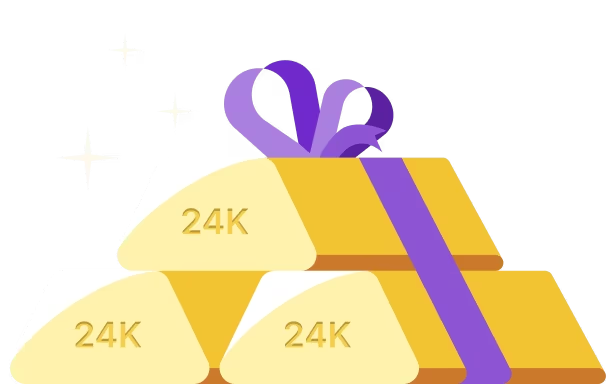1. Introduction
Gold Price Tool allows you to see Gold prices in real time and make decisions accordingly. The chart is automatically refreshed and the price is updated every minute. Easily check the Gold price today along with its purity. You can specifically check for a 1 gram Gold rate and 24KT Gold price today as well. See the Gold price performance today, 6 months, 1 year, 3 years and 5 years for Indian Rupees.
2. How is the hallmarked gold rate today in India determined?
Well, before you proceed to buy gold, there are some things that you need to be sure of. To own gold it is important to understand its purity, hallmarking, price and its making. Hallmark in gold or Hallmarked gold in India is nothing but a certificate of quality that is granted by the government of India (the Bureau of Indian Standards). It is important to note that there is no difference between the prices of normal gold and hallmarked gold. The difference lies in gold quality. There are no additional charges induced with hallmarked gold.
Hallmarked gold rates in India stand out as the gold that is bought should be of high quality. The BIS assesses the gold and checks if it meets the international standards of qualified gold and is pure too.
3. How can you be sure of hallmarked gold in India?
There are certain features that are present in hallmarked gold which assures its quality. It is engraved and has inscriptions. Hallmarked gold has the BIS logo, retailer’s logo, logo of the assaying centre, the year of certification and also the purity level. The gold that is hallmarked is found in the purity of 24 carat, 23 carat, 22 carat, 21 carat and 18 carat.
The difference in the number of carats is nothing but the total percentage of gold in the metal. The highest quality is 24 carat gold, that is totally pure. It is always advisable to buy gold that is BIS certified hallmarked gold.
4. Gold as an asset
Gold is considered to be an exclusive item of luxury. Gold plays a pivotal role in terms of investments. Possessing gold is simpler when compared to the purchase of other tangible assets like real estate. It eases the burden of losses during market fluctuations. Gold is tangible and highly liquid in nature. Certain classes of assets are often associated with misuse or fraud, but gold is free from such concerns.
However, gold is a liquid asset and there is a ready market for it. One of the drawbacks of gold is that it is difficult to sell at the market price. But you will certainly find a buyer for gold. However, you can pledge the gold for a loan and pay interest.
5. What is Gold price today in India per gram?
In India, gold has a sentimental significance attached to it. The yellow metal is associated with material wealth. Indian women like gold jewellery and can never have enough of it. Because gold is such an integral part of auspicious festivals, gold sales skyrocket around Diwali. The price of gold fluctuates on a daily basis; if you wish to acquire gold, start typing Put today’s gold rate into the Google search box and perform a Google search. If you want to find the El Dorado, you must keep up with the current gold rate.
Today’s gold price is impacted by different factors:
– Inflation – Gold is a secure investment and used as a hedge against inflation. Hence, the demand for gold rises when inflation is high, and vice versa. As a result of the increasing customer demand, the price of gold will increase.
– Government Gold Reserves – The price of gold rises as large countries’ central banks begin to retain gold reserves and purchase more gold. This is because the market’s cash flow increases when the supply of gold decreases.
– Jewellery Market – Gold prices rise throughout the wedding season, as well as during festivals like Diwali, as a result of increased consumer demand. Prices rise as a result of the demand-supply imbalance.
– Interest Rate Trends – Customers are more likely to sell gold to obtain cash when interest rates rise, hence an increase in gold supply leads to lower gold rates. Lower interest rates, on the other hand, result in more cash in the hands of customers, resulting in increased demand for gold and, as a result, an increase in the metal’s price.
6. How much do jewellers charge on purchasing Gold jewellery?
The Indian population has a fascination with gold. It is the most cherished metal, and it is flaunted in the form of jewellery on every occasion. The gold rate today in India is not standard. The gold price oscillates based on fluctuations in the market.
Purchasing gold is an exceptionally normal peculiarity among Indians. Celebrations and wedding festivities are not complete without gold. We regularly don’t wrangle the cost of gold a great deal while getting it from the neighbourhood diamond setter. Rather we shouldn’t indiscriminately believe the cost asked by the diamond setter, since there are many elements that influence the last sum, including making charges, gold value, worth of jewels and so on.
Right now, there is no such standard charging price in India and costs contrast from one gem dealer to another.
Here is the most ordinarily utilised recipe to work out the last cost of gold:
Last cost of the gems = Price of 22 KT gold X (weight in grams) + Making charges + GST at 3% on (cost of adornments + making charges)
Beneath referenced are a few factors that you ought to know about while purchasing gold to try not to be deceived:
* Gold must be pure
Gold is generally accessible in various Karats (KT), which is the proportion denoting the immaculateness of gold.
24KT gold is viewed as the most perfect type of gold yet it is too delicate to be in any way made into gems. Most famous type of gold accessible in adornments is of 22KT which has 91.6 percent gold. A few different metals like copper, zinc, cadmium or silver are added to the gold to make it more grounded.
*Studded jewels
Once in a while, individuals purchase adornments that have stone work on it. A few exploitative gem dealers gauge the whole adornment and furthermore charge for the stones in it. Also, if at any point you wish to trade/sell it back, the goldsmith ordinarily deducts the heaviness of the stone from the complete worth.
Accordingly, while purchasing gold you ought to be absolutely mindful that the worth of gold must be determined relying upon the heaviness of the adornments and lessening the heaviness of precious stones and gemstones.
Cost of gold gems relies upon:
a) gold in the gems, for example 22KT or 18KT
b) the metal blended in with the gold.
Gold is exchanged consistently and the interest and supply of the yellow metal decides its value consistently. The unadulterated gold rates are typically distributed in the news consistently, however the gold rate for various goldsmiths shifts as it depends from whom they are purchasing gold and at what cost. Nonetheless, the thing that matters is the exact moment.
*BIS Standard trademark
Hallmarking is the method involved with affirming the virtue of any gold gems. A trademark confirmation is given by the Bureau of Indian Standards (BIS) and endorses the immaculateness of gold.
BIS engraves its logo as an indication of trademark alongside hallmarking focus mark, fineness number and diamond setter’s recognizable proof imprint.
*Charges for the labour
Labour charges depend upon the kind of gold gems you are purchasing. This is on the grounds that each trimming requires an alternate way of cutting and wrapping up. It likewise shifts on the component how much fine specifying is required in a specific plan. Machine-made gems as a rule do not cost as much as man-made ones.
7. Sovereign Gold Bond Scheme: Should you invest in them?
Sovereign gold bonds are RBI-mandated certificates issued against gold that allow anyone to invest in gold without having to worry about keeping their physical asset safe. Should you invest in them? Take a look at these advantages and disadvantages of SGBs and choose yourself.
The difference in the number of carats is nothing but the total percentage of gold in the metal. The highest quality is 24 carat gold, that is totally pure. It is always advisable to buy gold that is BIS certified hallmarked gold.
Historical Gold Rates & Returns from 1965 – 2025
| Year | Price (₹) | YoY Return (%) |
| 1964 | 63.25 | – |
| 1965 | 71.75 | 13.43 |
| 1966 | 83.75 | 16.74 |
| 1967 | 102.5 | 22.44 |
| 1968 | 162 | 58.54 |
| 1969 | 176 | 8.64 |
| 1970 | 184 | 4.55 |
| 1971 | 193 | 4.89 |
| 1972 | 202 | 4.66 |
| 1973 | 278.5 | 37.89 |
| 1974 | 506 | 81.75 |
| 1975 | 540 | 6.73 |
| 1976 | 432 | -20 |
| 1977 | 486 | 12.5 |
| 1978 | 685 | 40.95 |
| 1979 | 937 | 36.86 |
| 1980 | 1,330.00 | 41.96 |
| 1981 | 1,670.00 | 25.56 |
| 1982 | 1,645.00 | -1.49 |
| 1983 | 1,800.00 | 9.3 |
| 1984 | 1,970.00 | 9.44 |
| 1985 | 2,130.00 | 8.12 |
| 1986 | 2,140.00 | 0.47 |
| 1987 | 2,570.00 | 20.09 |
| 1988 | 3,130.00 | 21.79 |
| 1989 | 3,140.00 | 0.32 |
| 1990 | 3,200.00 | 1.91 |
| 1991 | 3,466.00 | 8.31 |
| 1992 | 4,334.00 | 25.07 |
| 1993 | 4,140.00 | -4.5 |
| 1994 | 4,598.00 | 11.05 |
| 1995 | 4,680.00 | 1.78 |
| 1996 | 5,160.00 | 10.26 |
| 1997 | 4,725.00 | -8.44 |
| 1998 | 4,045.00 | -14.42 |
| 1999 | 4,234.00 | 4.71 |
| 2000 | 4,400.00 | 3.89 |
| 2001 | 4,300.00 | -2.27 |
| 2002 | 4,990.00 | 16.05 |
| 2003 | 5,600.00 | 12.23 |
| 2004 | 5,850.00 | 4.46 |
| 2005 | 7,000.00 | 19.66 |
| 2006 | 8,490.00 | 21.29 |
| 2007 | 10,800.00 | 27.21 |
| 2008 | 12,500.00 | 15.74 |
| 2009 | 14,500.00 | 16 |
| 2010 | 18,500.00 | 27.59 |
| 2011 | 26,400.00 | 42.7 |
| 2012 | 31,050.00 | 17.62 |
| 2013 | 29,600.00 | -4.7 |
| 2014 | 28,006.50 | -5.38 |
| 2015 | 26,343.50 | -5.92 |
| 2016 | 28,623.50 | 8.65 |
| 2017 | 29,667.50 | 3.65 |
| 2018 | 31,438.00 | 6.01 |
| 2019 | 35,220.00 | 12.05 |
| 2020 | 48,651.00 | 38.17 |
| 2021 | 48,720.00 | 0.14 |
| 2022 | 52,670.00 | 8.1 |
| 2023 | 65,330.00 | 24.06 |
| 2024 | 80,500.00 | 23.21 |
| 2025 (up to 29 May) | 97,172.00 | 20.70 (partial year) |
Last 5 years (2019 to 2024)
Return = ((Price_2024 – Price_2019) / Price_2019) * 100
= ((80,500 – 35,220) / 35,220) * 100 ≈ 128.56%
Last 10 years (2014 to 2024)
Return = ((Price_2024 – Price_2014) / Price_2014) * 100
= ((80,500 – 28,006.50) / 28,006.50) * 100 ≈ 187.54%.
Advantages
1. Payment of interest – On your SGB investment, the government offers a fixed annual interest rate. This interest payment is split into two parts and given to the investor every six months.
2. Demat and Paper Format –SGB is available in paper and demat format, which eliminates the cost and risk of holding physical gold. When you invest in SGB, you receive a holding certificate rather than real gold.
This means you won’t have to worry about your gold being secure or paying an annual charge to keep it in a bank locker.
3. Tax Advantage – The interest you get from your SGB investment is not subject to TDS. You can also transfer the bond before it matures to benefit from indexation.
Even capital gains tax will be waived if you redeem the bond beyond its maturity date. The interest, on the other hand, is completely taxable according to your income tax bracket.
Disadvantage
1. Maturity – Because gold bonds have an 8-year maturity period, many investors are put off by them.
The government has kept the maturity extended in order to avoid investors from losing money due to gold price volatility. It’s also worth noting that after 5 years from the date of purchase, investors can redeem the bond.
2. Capital Loss –Because the bond’s value is closely connected to the price of gold on international markets, your investment in SGB could result in a capital loss. You may incur a loss if the price at which you purchase the bond is higher than the price at which you redeem it at maturity.
However, gold is a valuable commodity, and the government works hard to maintain its price stable. And if you stay invested for 5-8 years, your odds of losing money are slim. However, it is impossible to rule out the idea entirely.
8. How is Gold used in Electronics?
Gold is considered to be the most useful and reliable metals due to its unique properties. Gold is a proficient conductor of electricity. It helps in carrying small units of charged particles throughout the circuit. It is an easy handle and a rust proof metal. Gold is used in trivial quantities in electronic devices. Gold is commonly used in adapters, switches and relay contacts, metal filler, linking wires or in terminal strips.Gold is an important component in almost all the electronic gadgets. For instance television sets, computers, mobile phones, calculators, personal trackers and GPS (global positioning system).
Today, the biggest modern utilisation of gold is in the gadgets business. Because of it being moderately more costly than different metals and the way that there is a deficiency of supply, there is a transition to reuse gold utilised in old hardware in light of the fact that its interest is still high in the business.
With this list of benefits of utilising gold to make electronic parts, no big surprise even with every one of the monetary difficulties its utilisation presents, it is as yet liked over copper and different conveyors in the creation of connectors and other sensitive parts.
9. Putting your gold safely in India
According to the government of India, a public authority’s Gold Monetization Scheme (GMS) permits you to store your inactive gold with a Reserve Bank of India (RBI) assigned bank and acquire revenue on the equivalent. This works like a bank fixed store. Contingent upon the residency of the GMS one decides on, one can procure up to 2.5% interest per annum.
Today, the biggest modern utilisation of gold is in the gadgets business. Because of it being moderately more costly than different metals and the way that there is a deficiency of supply, there is a transition to reuse gold utilised in old hardware in light of the fact that its interest is still high in the business.
The plan was sent off by the public authority in 2015 with an aim to place the inactive gold put away by people in their homes and bank storage spaces to useful use. Nonetheless, the plan didn’t track down numerous takers – one of the primary reasons being what befalls the gold you store with the bank.
According to the plan leads, the gold – adornments, bullion, curios – is expected to be stored with the bank and thus, the bank will test its immaculateness. When the immaculateness of the gold adornments is discovered, they will liquefy the gold gems and convert it into bullion or gold coins.
You can buy Digital Gold from Jar app that is totally secured in world-class vaults and insured by top banks of India.
10. The present import duty on gold
According to the government’s ‘Guide for Travellers,’ any passenger of Indian origin or a passenger with a valid passport who is returning to India after a stay outside of at least 6 months can bring gold as baggage. Short visits within these six months will be ignored if their overall duration does not exceed 30 days. Importantly, no other passengers will be allowed to bring gold into the nation in their luggage save for these passengers. The union government prohibits the importation of gold and silver by foreign nationals.
The traveller should pay the duty in a foreign currency that can be converted. Duty on gold bars other than tola bars having engraved serial numbers from the maker or refiner will be 12.5% , with a 1.25% Social Welfare Surcharge. Other than that, duty on gold in any form, including tola bars and ornaments, barring decorations encrusted with stones or pearls, will be 12.5%, plus a 1.25% Social Welfare Surcharge.
If staying for more than 6 months, Indian passport holders and those of Indian heritage will be eligible for a reduced duty rate on gold. Short trips of up to 30 days during the six-month period will be ignored. In all other circumstances, the standard Customs Duty rate of 38.5% is applied. The Customs Duty-Free Allowance, which is available to Indian passengers who have lived abroad for more than a year, is distinct. The charge for a man is Rs. 50,000, and the rate for a lady is Rs. 1,00,000.
One kilogramme of gold (including jewellery) is allowed per person, and it must be brought or imported within 15 days of arriving in India.
11. How does QE impact Gold prices in India?
The acronym QE stands for Quantitative Easing. Quantitative easing is increasing the amount of money available in the economy to boost spending. Central banks around the world buy securities, resulting in an increase in the economy’s money supply. This additional money supply finds its way into worldwide gold assets, raising gold prices.
A rise in the QE has an impact on the gold rate in India today, which impacts all forms of gold, including the popular 916 gold rate. Lately, there hasn’t been much quantitative easing (QE) taking place around the world. The United States has completed its quantitative easing (QE) phase, and several central banks in Japan and Europe are easing.
At this time, it appears that QE in that country is improbable. Gold rates may fall in the market if the global economy experiences any liquidity concerns. Other factors, in addition to quantitative easing, contribute to gold’s ascent. Gold prices will decline as QE is phased out. As the United States’ quantitative easing programme comes to an end, gold prices in India may be affected.
12. Factors that influence gold prices in India
Factors that influence Gold prices in India are:
1. Inflation – Gold is a secure investment and used as a hedge against inflation. Hence, the demand for gold rises when inflation is high, and vice versa. As a result of the increasing customer demand, the price of gold will increase.
2. Government Gold Reserves – The price of gold rises as large countries’ central banks begin to retain gold reserves and purchase more gold. This is because the market’s cash flow increases when the supply of gold decreases.
3. Jewellery Market – Gold prices rise throughout the wedding season, as well as during festivals like Diwali, as a result of increased consumer demand. Prices rise as a result of the demand-supply imbalance.
4. Interest Rate Trends – Customers are more likely to sell gold to obtain cash when interest rates rise, hence an increase in gold supply leads to lower gold rates. Lower interest rates, on the other hand, result in more cash in the hands of customers, resulting in increased demand for gold and, as a result, an increase in the metal’s price.
13. Gold – A special niche
Gold is rare, non-corrosive, provides sustainable storage value, and attracts people physically and emotionally. Society and economy endow gold with value, thereby maintaining its value. We see it not only as a symbol of wealth and prosperity, but also as an investment against the effects of inflation.
Investing in this precious metal is a good choice as it helps in neutralising the effects of other high-risk investment instruments such as mutual funds and stocks. It performs well even in volatile markets. Additionally, it has the potential to improve risk factors. While other assets go down, gold is the only asset which grows.
14. Method for buying gold in India
You can invest in gold through the following methods:
-
- Physical Gold (Jewellery, Coins, etc)
-
- Digital Gold
-
- Gold ETFs (Exchange-Traded Funds)
-
- Gold mutual funds
-
- SGBs (Sovereign Gold Bonds)
15. Demand for Gold in India
The love for gold is beyond words. The magnificence of gold is dated back to ancient times where gold was known for its exquisiteness and glow. The word gold is derived from the Greek name Aurora, meaning the goddess of the dawn. During the prehistoric period the colour of gold was often linked to the Sun.
Gold holds the most prominent place in Indian markets. Urban populace considers this precious metal as the epitome of wealth and forms an integral part of any festivities or celebrations. Contrarily, the rural inhabitants embrace gold for security considerations and as an investment for the future.
Gold jewellery pieces, favours or largesse, benevolences hold a special place in Indian society. We often notice gold ornaments are sported by people during family gatherings and celebrations. Wedding ceremonies are incomplete without gold jewellery for the bride or bridegroom. The big fat Indian weddings constitute 50 percent of annual gold demand across the country. Moreover, Indian culture vouches for obtaining gold during auspicious festivals like Diwali, Akshaya Tritiya, Pongal, Onam, Ugadi, Durga Puja and Baisakhi.
15. Demand for Gold in India
1. Inflation – Gold is a secure investment and used as a hedge against inflation. Hence, the demand for gold rises when inflation is high, and vice versa. As a result of the increasing customer demand, the price of gold will increase.
2. Government Gold Reserves – The price of gold rises as large countries’ central banks begin to retain gold reserves and purchase more gold. This is because the market’s cash flow increases when the supply of gold decreases.
3. Jewellery Market – Gold prices rise throughout the wedding season, as well as during festivals like Diwali, as a result of increased consumer demand. Prices rise as a result of the demand-supply imbalance.
4. Interest Rate Trends – Customers are more likely to sell gold to obtain cash when interest rates rise, hence an increase in gold supply leads to lower gold rates. Lower interest rates, on the other hand, result in more cash in the hands of customers, resulting in increased demand for gold and, as a result, an increase in the metal’s price.
17. Why do we need to invest in Gold in India?
Investing in Gold has many benefits:
-
- It acts as a hedge against inflation
-
- Best instrument to add to your investment portfolio among stock market and real estate
-
- It has high liquidity and trading – Easy to buy and sell in the market
-
- It does not deteriorate with time
-
- It’s price is stable
-
- It can be easily passed on to successors
-
- You can easily get a loan against Gold
-
- It does not require much maintenance
You can buy it in different forms like Digital Gold, Jewellery, Coins, SGBs, Mutual Funds, etc.
18. Has gold investment in India delivered returns?
Gold rates have been increasing for the past 92 years. Apart from having cultural importance in India, gold also has intrinsic value and has been a great asset with even better returns YoY. It’s a great instrument to add to your investment portfolio.
The average annual return of gold investments and other assets worldwide is around 10.61%. Whereas, the long term returns are 5-12%.
19. Why is checking gold prices today important?
Gold forms an integral part of Indian culture. The gold prices are skyrocketing during festivals like Dhanteras or Akshay Tritya. Possessing this metal indicates riches and a sense of security. Gold rate fluctuates on and off. So in case you are planning to buy gold keep a close watch on the gold rates. On a daily basis, gold rates are exhibited in news channels, newspapers or you can straight away hit on Google search engine.
Women and investors are the key players in dealing with gold. Women adorn gold in the form of jewellery. Whereas investors buy it for investment purposes in the form of gold coins, gold bars, gold ETFs etc. But financial experts warn against possessing gold jewellery for investment commitments. Since, it is a dead asset. It brings hidden making charges, bringing you to bear additional costs.
Today’s gold price might not be the same as tomorrow. Gold rate is influenced by many factors like demand and supply, market fluctuations across the world and volatility of US dollar etc. Moreover, factors such as tax policies, overhead costs, local connotations and religious sentiments etc. also affect the gold price in parts of the region.
20. How much is one tola gold?
Tola, often spelled tolah or tole, is a Hindi word for gold measurement used in India and other Asian countries. A tola of gold is currently equal to 10 grams of Gold.
21. How to buy gold in India?
In India, buying gold is rather simple because genuine gold jewellery shops can be found practically anywhere. Gold can be found in a variety of places, from major franchises to little businesses. In this golden land, you can get regular 22 carat gold, 23 carat gold, and pure 24 carat gold. However, before going to the nearest jeweller, perform a Google search for Gold Rate Today or Today Gold Rate to get the most up-to-date gold prices.
The best way to buy Gold is Digital Gold. One can buy digital gold from any registered apps and intermediaries. 99.99% pure and safe Digital Gold can be bought from Jar App for as low as ₹10. Backed by NPCI and the best UPI service providers in the market, Jar app automatically invests your savings in this popular asset, therefore promoting a habit of saving daily. Digital gold can be bought without KYC but only up to a certain amount depending on the platform used to buy it. On some popular apps up to ₹50,000 worth of gold can be bought without any requirement of KYC. On the Jar App, you can buy up to 30 grams of digital gold without KYC.
22. Purity of gold
The Different Karats of GoldKarat is the term used to quantify the gold substance or immaculateness. Before we comprehend the distinction between 24k, 22k and 18k gold, you should know a big motivator for karat. Karat is essentially a unit used to gauge the immaculateness of gold. The higher the karatage, the cleaner the gold. Here is a straightforward manual for getting the distinction between 24k, 22k and 18k gold.
*24K gold
24k gold is likewise called unadulterated gold or 100% gold. This implies that every one of the 24 sections in the gold are for the most part unadulterated gold without hints of some other metals. It is known to be 99.9 percent unadulterated and takes on an unmistakable radiant yellow tone. There could be no higher type of gold than 24K and you should know about this before you go to a vendor who could let you know that they’re selling you 25K or 26K gold. Since this is the most flawless type of gold, it is normally more costly than 22K or 18K gold. In any case, this sort of gold is lesser in thickness when contrasted with gold of a lower karatage which makes it delicate and flexible. Subsequently, it isn’t appropriate for standard types of adornments. Coins and bars are generally purchased of 24K gold virtue. 24K gold is additionally utilised in gadgets and clinical gadgets, for example, those utilised for youngsters experiencing ear contaminations who are fitted with gold tympanostomy tubes that are known to further develop air circulation of the centre ear.
*22K gold
22K gold adornments imply that 22 pieces of the gems add up to gold and the equilibrium 2 sections are a few different metals. This sort of gold is regularly used in adornments making. In 22K gold, of the 100%, just 91.67 percent is unadulterated gold. The other 8.33 percent includes metals like silver, zinc, nickel and other compounds. This expansion of metals make the surface of gold harder along these lines making the adornments sturdy. In any case, you should know that albeit this can be utilised to make plain gold adornments, 22K gold isn’t ideal for precious stones and intensely studded gems.
*18K gold
18K gold is 75% gold blended in with 25% of different metals like copper or silver and so forth Generally studded gems and other precious stone gems are made in 18K gold. This sort of gold is more affordable contrasted with 24K and 22K. This one has a marginally dull gold tone. Perceiving 18K adornments is somewhat straightforward – you will see the thing stepped with 18K, 18Kt, 18k or a variety like these. Now and again, 18K gold is set apart by 750, 0.75 or a stamp like these to represent that the adornments contain 75% gold.
23. 916 hallmarked gold rate in India
22 carat gold is also referred to as 916 gold. It is used to indicate the purity of gold in the end product, i.e. there are 91.6 grams of pure gold in every 100 grams of alloy. 916 Gold is great for jewellery production and is also BIS certified. 958 Gold is 23 carat gold, while 750 Gold is 18 carat gold.
24. Taxes on gold in India
The most common way of buying gold is in the form of jewellery, gold bars, coins and digital gold.
Capital gains from the sale of physical gold is taxed based on whether it is short term or long term capital gains.
If you sell your gold assets (which may be gold jewellery, digital gold or coins) within three years from the date of purchase, any proceeds from that sale will be considered Short-Term Capital Gains(STCG).
It will basically be added to your annual income and as a result you will have to pay tax effectively on the highest income tax slab under which your income falls.
On the other hand, If you sell your jewellery, gold coins or digital gold after three years or more from the date of purchase, the proceeds from the sale will be classified as Long-Term Capital Gains (LTCG).
Long-term capital gains from the sale of gold assets are taxed at 20%, with applicable surcharge and education cess.
In simple words, you have to calculate taxes with indexation. Indexation is a process by which the acquisition cost is adjusted with the inflation by inflating it by rate of inflation during the holding period.
The higher the value, the lower the profit, and therefore the lower the total tax revenue.
25. Reasons to buy Gold in India
Status Symbol: In India, where individuals enjoy flaunting their money, Gold, especially Gold Jewellery, has become a status symbol. We associate it with wealth, power and status. Also indicating a person or a family’s ability to purchase gold even when prices climb.
Family heirloom: Gold jewellery is an important family heirloom for most Indian households. It is passed down from generation to generation to preserve the family legacy. Sacred and sign of Prosperity: According to Hindu mythology, Gold is considered sacred and pure. It possesses a high emotional quotient and a higher perceived value. It brings people closer together and strengthens bonds between them. Gold is also traditionally associated with Laxmi, the Goddess of Prosperity, and Kuber, the God of Wealth. Hence, purchasing Gold is considered equivalent to inviting Gods at home.
Good Investment: The faith that Indians have in gold as a means of investing is unrivalled. Due to its tangibility, gold has traditionally been regarded as the safest investment (safer than land, property and even mutual funds) due to its ability to function as a hedge against inflation. This is a valuable commodity that can also provide financial security in times of political and economic turmoil. This yellow metal is part of a well-diversified investment portfolio – always seen as a long-term investment.
Gifting: Gifting Gold is regarded auspicious in India. Giving gold to someone allows them to not only use it, but also to use it as a source of funds in times of economic uncertainty. It is regarded as the highest form of gifting in our country, highlighting the value of an individual and the purity of intent.
Religious Connotations: Gold is an important aspect of every religious ceremony in the country, regardless of religion. The devotees don’t even flinch when it comes to donating gold to temples, despite the rising prices.
Liquidity: Gold is a popular investment and savings option due to its liquidity. Gold, unlike stocks, bonds, real estate, and other financial assets, can quickly be changed into liquid cash, making it a popular financial asset for people of all socioeconomic backgrounds.
26. Why is gold a good investment bet in India?
Well-planned Gold investments can pay out handsomely. Purchasing Gold is similar to holding a form of currency, which increases its security when compared to risky stock purchases. Gold can help you balance your portfolio, function as an inflation hedge, and provide excellent long-term capital returns.
Long-term capital gains (even if they are only three years old) after the sale of goods are taxed at 20% with additional perks.
For the past 92 years, Gold prices have been steadily rising. Gold has intrinsic value and has been a terrific asset in India, with even stronger returns YoY. Gold is traditionally seen as a solid investment alternative when compared to diamonds or platinum, which do not have the same resale value as Gold.
Investing in Gold has many benefits:
-
- It acts as a hedge against inflation.
-
- Best instrument to add to your investment portfolio among stock market and real estate.
-
- It has high liquidity and trading – Easy to buy and sell in the market
-
- It does not deteriorate with time
-
- It’s price is stable
-
- It can be easily passed on to successors
-
- You can easily get a loan against Gold
-
- It does not require much maintenance
27. Physical Gold vs. Digital Gold
Size of investment: When investing in physical gold, you need to buy at least 1 gm of gold, whose price fluctuates everyday. Whereas, investing in digital gold is very affordable and can be bought and sold from as low as ₹1. It’s affordable and you can easily invest in digital gold even with limited income.
Storage: In our Indian households, we’ve usually seen our elders keeping physical gold in lockers. That’s very risky as there’s always a fear of it getting stolen. To avoid this, it is kept in a bank locker for the long-term which then incurs storage costs in the form of registration fees, annual fees, service fees, etc.
Digital Gold allows you to get rid of long-term costs and storage problems. The safe is free or insured at face value.
High liquidity: Compared with other asset classes, gold is the most liquid commodity. However, physical gold still faces liquidity issues, such as: to liquidate physical gold and get the complete resale value for it, selling it to the dealer from whom you bought it is mandatory. The original purchase bill is also a requirement in order to get the entire resale value.
Digital gold can be easily bought and sold anywhere and anytime. You don’t need to visit a dealer or keep a secure gold purchase account for many years to get the full resale value of the gold in the future.
Trading: Trading digital gold is more convenient than trading physical gold. To buy or sell physical gold, you have to postpone one day and go to a jewellery store or bank, which is time-consuming and inconvenient. If you want to buy gold, you need to have a gold locker on hand.
On the other hand, digital gold can be bought and sold online anytime, anywhere, in just a few simple steps. After a successful sale, the money gets directly transferred to your registered wallet or bank account within a few days.
What you pay for: When buying gold jewellery, you not only have to pay the price of gold, but also making charges and additional taxes. Jewellers charge anywhere from 7% to 25% based on the design of your jewellery. If the chosen piece of jewellery includes precious stones and gems, the cost increases and its value is also included in the gold price. When you deal with gold jewellery, you never need to collect or restore the value of those inlaid jewellery.
With digital gold, you only trade pure gold, which is 24 carats of gold. The total amount you spend is invested in gold only. You only have to pay 3% GST at the time of making the purchase.
Safety: Many people are reluctant to invest in digital gold because it is a new concept and they lack knowledge in this area. But not to worry, digital gold is safe as an investment choice. Every gram of gold accumulated in your account is backed by real physical gold. This means that you are at no risk at any time.
28. Why are Gold rates different in different cities in India?
Ever noticed, the price of Gold differs from state to state? The price would be different in Delhi and in Mumbai? Here are the reason why this happens:
Taxes: State taxes fluctuate from one state to the next. Taxes in some states are greater than in others. As a result, gold costs more in some cities than in others.
Demand: Gold demand varies due to varied populations and demographics. Larger volume discounts are frequently available. As a result, gold prices in cities like Mumbai are lower due to higher transaction volumes.
Carriage: India imports the majority of its gold by sea. Due to the lack of inland transportation taxes, gold prices in port towns such as Chennai are lower than those in interior locations such as Delhi.
Local gold associations: Each city has its own local gold association, which has a role in pricing setting. Differences in gold prices between cities will also be accounted for.
29. What is the difference between 22K and 24K Gold?
Gold’s fineness or purity is measured in karats. Because gold is such a malleable metal, it is too soft to achieve form on its own. To achieve shape, it is frequently alloyed with another metal, most commonly copper. The purity of gold is then measured in karats, which are the portions of gold that are present out of a total of 24.
The purity of 24 karat gold is 99.99 percent, while 22 karat gold is 91.67 percent. The alloy 22 karat gold is made up of 22 parts gold and 2 parts alloyed metal.
Although 24k gold is more expensive than 22k gold because it is purer, some individuals choose 22k gold because it is more durable. Import duties on 24k gold are often lower than those on 22k gold.
30. How Gold steers the economy?
Gold, directly or indirectly, impacts the economy of any country – be it at the mining stage, the refining stage, the production stage or trading stage. Let’s take a look at all the factors.
*Gold imports have the potential to depreciate a currency’s value: If a country’s export value exceeds its import value, its currency will strengthen. On the other hand, if a country imports far more than it exports, the value of its currency would depreciate.
Similarly, a country that exports Gold would see a rise in the value of its currency as the Gold rate rises today, as the value of the country’s exports rises.
*Rates of interest: Interest rates are linked to Gold prices. Low interest rates make Gold a good alternative to bonds and other fixed-income investments, which pay little in income and risk losing a lot of value if rates rise.
High interest rates, on the other hand, make bonds considerably more appealing than non-income-producing assets like Gold, and the high borrowing cost for investors who must take out loans to acquire Gold causes demand for the yellow metal to dry up more quickly than usual.
*Inflation: As the value of financial assets such as stocks and bonds is threatened by inflation, Gold becomes increasingly appealing as a store of value. Because inflation is typically associated with periods of economic turmoil, many investors consider Gold to be a safe haven asset that may be used in a variety of situations, from geopolitical war to systemic financial instability.
When investors lose faith in currency, they naturally resort to Gold, which tends to drive up prices. Of course, the fact that these and other factors tend to move in opposite directions at the same time highlights how difficult it is to identify the link between economic conditions and Gold prices.
*Markets for currencies: Gold prices, on the whole, tend to mirror changes in the value of the US dollar in relation to other currencies. When the dollar is strong, Gold will be more expensive in foreign countries whose currencies have depreciated in value, even though Gold prices remain unchanged in dollar terms.T
his tends to reduce demand and put downward pressure on Gold prices in dollar terms. When the dollar weakens, the converse is true: dropping foreign-currency costs make Gold more appealing to buy, increasing demand and pushing Gold prices higher.
*Gold mining: India’s socio economic development is significantly boosted by Gold mining. Mining also aids in the development of infrastructure and the establishment and maintenance of related service sectors, all of which often last well beyond the mine’s operational life. The country’s Gold mining business has been essentially inconsequential.
In 2015, India mined about 45,000 ounces of Gold, and its total Gold output, including Gold produced as a by-product of copper mining on the subcontinent, is little over 1.5 tons.
*Gold Production: Currently, 5-10% of India’s Gold manufacturing sector may be classified as “organised” large-scale operations, whereas these would have been unheard of just ten years ago. Nearly 65% of Indian jewellery is handcrafted, and the vast bulk of the industry is still dominated by small workshops with two to four Goldsmiths.
The current account deficit will be impacted. Although oil imports are the primary cause of India’s significant current account deficit (CAD), Gold imports, which make for the second highest portion of the country’s import bill, are also a contributing factor. When a country’s total imports and transfers exceed its total exports, a country is said to be in CAD.
*The expanding Gold loan industry: The practice of pledging Gold as collateral has long been a part of India’s Gold market.Formal (banks and non-banking financial businesses) and informal (individuals) Gold loan providers exist everywhere. This creates a big impact as, for example, Gold loan companies were successful in persuading the government to restore the 75 percent LTV (loan-to-value) ceiling in 2014 after a period of lobbying, and business has since recovered.
31. Why is the gold price increasing in India?
The country’s gold rates fluctuate frequently, depending on a variety of circumstances. A closer examination of current developments may reveal the cause of these shifts. The following are some of the most common influences on gold prices in India.
Demand: When demand outnumbers supply, gold prices rise. Because gold is a natural resource, it is limited in availability, and as supply decreases, gold prices rise.
International ties: Because India relies on imports to meet its domestic demand, international trends have a significant impact on gold rates in India. Any changes in international relations could result in a shift in gold prices in the local market.
US currency: When it comes to international gold pricing, the US dollar is crucial. When the dollar underperforms, gold does poorly, and vice versa, resulting in more expensive gold.
Market circumstances: Gold prices are inversely linked to market performance, rising whenever markets are under pressure.
Taxes and duties imposed by the government: A variety of commodities, including gold, are subject to government taxes and tariffs. Any increase in these taxes causes gold rates to rise, putting a strain on buyers’ wallets.













